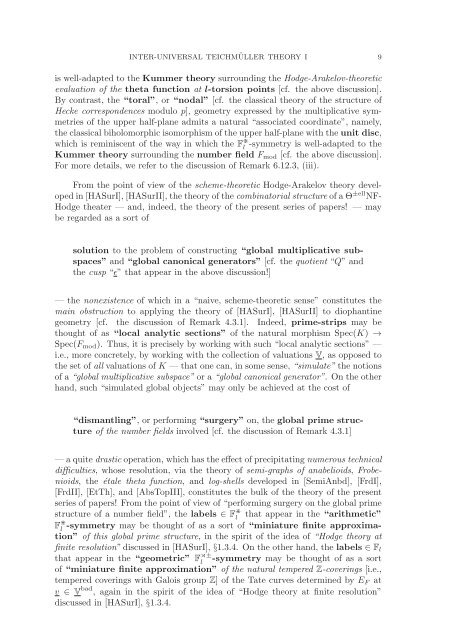Inter-universal Teichmuller Theory I: Construction of Hodge Theaters
Inter-universal Teichmuller Theory I: Construction of Hodge Theaters
Inter-universal Teichmuller Theory I: Construction of Hodge Theaters
You also want an ePaper? Increase the reach of your titles
YUMPU automatically turns print PDFs into web optimized ePapers that Google loves.
INTER-UNIVERSAL TEICHMÜLLER THEORY I 9<br />
is well-adapted to the Kummer theory surrounding the <strong>Hodge</strong>-Arakelov-theoretic<br />
evaluation <strong>of</strong> the theta function at l-torsion points [cf. the above discussion].<br />
By contrast, the “toral”, or“nodal” [cf. the classical theory <strong>of</strong> the structure <strong>of</strong><br />
Hecke correspondences modulo p], geometry expressed by the multiplicative symmetries<br />
<strong>of</strong> the upper half-plane admits a natural “associated coordinate”, namely,<br />
the classical biholomorphic isomorphism <strong>of</strong> the upper half-plane with the unit disc,<br />
which is reminiscent <strong>of</strong> the way in which the F l<br />
-symmetry is well-adapted to the<br />
Kummer theory surrounding the number field F mod [cf. the above discussion].<br />
For more details, we refer to the discussion <strong>of</strong> Remark 6.12.3, (iii).<br />
From the point <strong>of</strong> view <strong>of</strong> the scheme-theoretic <strong>Hodge</strong>-Arakelov theory developed<br />
in [HASurI], [HASurII], the theory <strong>of</strong> the combinatorial structure <strong>of</strong> a Θ ±ell NF-<br />
<strong>Hodge</strong> theater — and, indeed, the theory <strong>of</strong> the present series <strong>of</strong> papers! — may<br />
be regarded as a sort <strong>of</strong><br />
solution to the problem <strong>of</strong> constructing “global multiplicative subspaces”<br />
and “global canonical generators” [cf. the quotient “Q” and<br />
the cusp “ɛ” that appear in the above discussion!]<br />
—thenonexistence <strong>of</strong> which in a “naive, scheme-theoretic sense” constitutes the<br />
main obstruction to applying the theory <strong>of</strong> [HASurI], [HASurII] to diophantine<br />
geometry [cf. the discussion <strong>of</strong> Remark 4.3.1]. Indeed, prime-strips may be<br />
thought <strong>of</strong> as “local analytic sections” <strong>of</strong> the natural morphism Spec(K) →<br />
Spec(F mod ). Thus, it is precisely by working with such “local analytic sections” —<br />
i.e., more concretely, by working with the collection <strong>of</strong> valuations V, as opposed to<br />
the set <strong>of</strong> all valuations <strong>of</strong> K — that one can, in some sense, “simulate” the notions<br />
<strong>of</strong> a “global multiplicative subspace” or a “global canonical generator”. On the other<br />
hand, such “simulated global objects” may only be achieved at the cost <strong>of</strong><br />
“dismantling”, orperforming“surgery” on, the global prime structure<br />
<strong>of</strong> the number fields involved [cf. the discussion <strong>of</strong> Remark 4.3.1]<br />
— a quite drastic operation, which has the effect <strong>of</strong> precipitating numerous technical<br />
difficulties, whose resolution, via the theory <strong>of</strong> semi-graphs <strong>of</strong> anabelioids, Frobenioids,<br />
the étale theta function, and log-shells developed in [SemiAnbd], [FrdI],<br />
[FrdII], [EtTh], and [AbsTopIII], constitutes the bulk <strong>of</strong> the theory <strong>of</strong> the present<br />
series <strong>of</strong> papers! From the point <strong>of</strong> view <strong>of</strong> “performing surgery on the global prime<br />
structure <strong>of</strong> a number field”, the labels ∈ F l<br />
that appear in the “arithmetic”<br />
F l<br />
-symmetry may be thought <strong>of</strong> as a sort <strong>of</strong> “miniature finite approximation”<br />
<strong>of</strong> this global prime structure, in the spirit <strong>of</strong> the idea <strong>of</strong> “<strong>Hodge</strong> theory at<br />
finite resolution” discussed in [HASurI], §1.3.4. On the other hand, the labels ∈ F l<br />
that appear in the “geometric” F ⋊±<br />
l<br />
-symmetry may be thought <strong>of</strong> as a sort<br />
<strong>of</strong> “miniature finite approximation” <strong>of</strong> the natural tempered Z-coverings [i.e.,<br />
tempered coverings with Galois group Z] <strong>of</strong> the Tate curves determined by E F at<br />
v ∈ V bad , again in the spirit <strong>of</strong> the idea <strong>of</strong> “<strong>Hodge</strong> theory at finite resolution”<br />
discussed in [HASurI], §1.3.4.
















